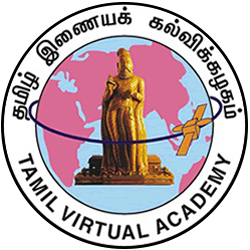Primary tabs
-
d03144 Lesson 4 Porulani Iyal - IV
This lesson talks about anigal 15 to 21 mentioned in the "Dandialangaaram". The 7 anigal discussed in this lesson are "Lesa Ani", "Niralnirai Ani", "Aarvamozhi Ani", "Suvai Ani", "Thanmembaattu Urai Ani", "Pariyaaya Ani" and "Samaagitha Ani". The lesson defines these figures of speech, lists their classifications and explains them through appropriate examples from literary texts mentioned in the "Dandialangaaram".
The feelings in one's heart are expressed through the eyes, facial expressions, gestures and other kinds of body language. Attributing these expressions to other external factors instead of the emotions in one's own heart is called "Ilesa Ani". "Vanja Pugazhchi Ani" ('irony' in English) which is the expression of one's ideas by saying something that is the direct opposite of one's thoughts is also a form of "Ilesa Ani".
Juxtaposition of a series of words with their meaning or with another list of words bearing the same meaning is called Niralnirai Ani. The two types of Niralnirai Ani are "Nerniralnirai Ani" and "Edhirniralnirai Ani".
The technique of using a large number of words that express excessive happiness or love is called "Aarvamozhi Ani". The vivid expression of the 8 types of emotions or sentiments is called "Suvai Ani". The figure of speech used to praise oneself or wax eloquent about one's attributes is called "Thanmembaattu Urai Ani". The technique of expressing one's thoughts without explicitly stating them, but, by implying them through clever suggestion is called "Pariyaaya Ani". An action may not produce the intended result. However, the desired result may sometimes be the natural outcome of another action. The figure of speech that demonstrates this is called "Samaagita Ani".


